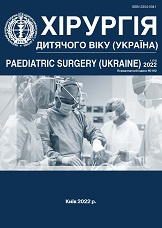Differentiated approach in the treatment of fractures of the distal humerus in children based on the use of bioabsorbable implants
DOI:
https://doi.org/10.15574/PS.2022.74.97Keywords:
children, bioabsorbable implants, fractures of the distal humerus, trauma in children, growth zones, osteosynthesisAbstract
In the practice of pediatric traumatologists there are a number of complex problems in the treatment of fractures of the distal humerus, which require a differentiated approach: atraumatic anatomical reposition with minimal damage to active growth zones, minimal damage to articular cartilage during surgery, stable fixation and early rehabilitation.
At present, the generally accepted methods of osteosynthesis (fixation with K - wires, metal screws, etc.) do not fully meet the requirements of modern pediatric traumatology. One of the newest methods of fixation in the treatment of fractures of this localization, which have significant advantages is the use of bioabsorbable implants (BAI).
Purpose - to present a differential approach to the treatment of distal fractures of the humerus in children based on the use of bioabsorbable implants.
Materials and methods. During the period from 2015 to 2021, 15 children aged 5 to 17 were treated at the Chernihiv Regional Children’s Hospital. Distribution by type of pathology: epiphyseal fracture of the humeral condyle head - 5, osteoepiphyseolysis of the lateral humerus condyle - 2, fracture of the medial epicondyle of the humerus - 8 cases. Damage to nerve and vascular structures was never diagnosed in this group of patients. At the preoperative stage, radiography of the elbow joint in standard projections for such injuries was used to diagnose the above injuries.
In the course of surgery, bioabsorbable cannulated screws and Bioretec pins were used to fix the repositioned fragments.
Results. In the process of surgery, standard approaches and repositioning techniques were used, according to the anatomical features of each fracture. The differentiated approach was to use cannulated screws in the case of osteosynthesis of extra-articular fractures (osteoepiphyseolysis of the medial epicondyle of the humerus) in older children (12 to 17 years), which allowed to create dosed compression of fragments and bioabsorbable perfect anatomical reposition. In 1 case there was a combined osteosynthesis: fixation of the metaphyseal fragment with a K - wires and synthesis of the intra-articular epiphyseal fragment with a bioabsorbent pin.
Advantages of BAI: minimal damage to articular cartilage, preservation of congruence and anatomical shape of the articular surface at the site of implant placement (Pin), stable fixation and interfragmentary compression (autocompression property), intraoperatively received full range of motion in the joint.
All patients received full consolidation in time according to the age of the injured child. The range of motion and function of the limb is completely restored. The children did not need repeated surgery.
Conclusions. 1. The advantages of using bioabsorbable implants in cases of treatment of fractures of the distal humerus in children are demonstrated. 2. The use of BAI allows to minimize damage to the growth zones and joint surface during osteosynthesis, provides stable fixation and interfragmentary compression, creates conditions for optimal fracture fusion and further rehabilitation. 3. Due to the properties of bioabsorption there is no need to remove the implant, ie re-trauma to the structures of the elbow joint of the growing organism, no need for re-hospitalization, anesthesia and surgery, re-rehabilitation, reduces the likelihood of psychological trauma in children. 4. As a result, all of the above improves the anatomical and functional results of treatment of these injuries, saves financial costs of both the medical institution and the state, and reduces the stress on family budgets.
The research was carried out in accordance with the principles of the Helsinki declaration. The informed consent of the patient was obtained for conducting the studies.
No conflict of interests was declared by the authors.
References
Azar FM, Beaty JH. (2021). Campbell's Operative Orthopaedics, fourteenth edition. Elsevier Inc.
Koh KH, Seo SW, Kim KM, Shim JS. (2010). Clinical and radiographic results of lateral condylar fracture of distal humerus in children, Journal of Pediatric Orthopaedics. 30 (5): 425-429. https://doi.org/10.1097/BPO.0b013e3181df1578; PMid:20574257
Kontakis GM, Pagkalos JE, Tosounidis TI, Melissas J, Katonis P. (2007). Bioabsorbable materials in orthopaedics. Acta Orthop Belg. 73 (2): 159-169.
Korhonen L, Perhomaa M, Kyrö A, Pokka T, Serlo W, Merikanto J et al. (2018). Intramedullary nailing of forearm shaft fractures by biodegradable compared with titanium nails: Results of a prospective randomized trial in children with at least two years of follow-up. Biomaterials. 185: 383-392. https://doi.org/10.1016/j.biomaterials.2018.09.011; PMid:30292588
Mencio GA, Swiontkowski M F. (2015). Green's skeletal trauma in children. Fifth edition. Elsevier Inc.
Poircuitte JM, Popkov D, Huber H, Polirsztok E, Lascombes P, Journeau P. (2015). Resorbable osteosynthetic devices in pediatric traumatology: a prospective series of 24 cases. European journal of orthopaedic surgery & traumatology: orthopedie traumatologie. 25 (6): 997-1004. https://doi.org/10.1007/s00590-015-1656-8; PMid:26084895
Downloads
Published
Issue
Section
License
Copyright (c) 2022 Paediatric Surgery (Ukraine)

This work is licensed under a Creative Commons Attribution-NonCommercial 4.0 International License.
The policy of the Journal “PAEDIATRIC SURGERY. UKRAINE” is compatible with the vast majority of funders' of open access and self-archiving policies. The journal provides immediate open access route being convinced that everyone – not only scientists - can benefit from research results, and publishes articles exclusively under open access distribution, with a Creative Commons Attribution-Noncommercial 4.0 international license(СС BY-NC).
Authors transfer the copyright to the Journal “PAEDIATRIC SURGERY.UKRAINE” when the manuscript is accepted for publication. Authors declare that this manuscript has not been published nor is under simultaneous consideration for publication elsewhere. After publication, the articles become freely available on-line to the public.
Readers have the right to use, distribute, and reproduce articles in any medium, provided the articles and the journal are properly cited.
The use of published materials for commercial purposes is strongly prohibited.

